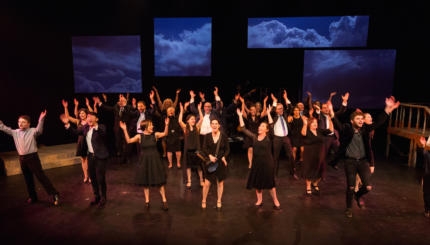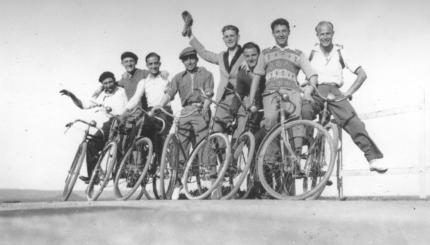Louise Nevelson is best known as a renaissance woman who blurred the boundaries between sculpture and assemblage, collage and woodworking.
At first glance, her art looks like discarded junk. Nevelson, who died in 1988, collected wood from the street corners of Manhattan and placed them in boxes she’d built, painting the entire business with a monochromatic coat (first black, then white and gold). The heaps of boxes filled with assorted shapes (with a variety of textures from splintered to smooth wood, often with errant nails sticking out) could be confused with an abandoned factory, with alien machines that long ago ceased to function.
“When you put together things that other people have thrown out,” she maintained, “you’re really bringing them to life–spiritual life that surpasses the life for which they were originally created.” Indeed, Nevelson’s sculptures-paintings-collages appear far too orderly to be trash.
Uncomfortable Memories
Louise Nevelson was born Leah Berliawsky in Kiev, Ukraine, in 1899. Eventually, the Berliawskys left for America, settling in Rockland, Maine in 1905. As an Orthodox Jew she faced discrimination from her peers. Yet, with the help of a friendly local Roman Catholic priest and funds from the New York-based Abraham and Straus department store the Berliawskys helped found Adas Yeshuron, Congregation of the People of Israel in Rockland.
Still, Nevelson’s memories were primarily uncomfortable ones: “We were an immigrant family, foreigners in a Daughters of the Revolution town … they needed foreigners like I need ten holes in my head.”
Budding Artist
Nevelson studied full time at the Art Students League in New York from 1929 to 1930. Forever racing against the grain, in 1931 Nevelson traveled to Munich at a time when Jews were trying to flee to study with renowned German abstract expressionist Hans Hoffman. Through Hoffman, Nevelson fell in love with Cubism, an encounter she described as “like when some people find God, and I have never left it.”
And yet, Nevelson would leave cubism and lay the groundwork for the later craze for installation art. After a second trip to Europe (this time, Paris), Nevelson enrolled in the Art Students League again in 1932, studying with Hoffman, who had managed to immigrate to New York. Over the next two years, she worked in Mexican muralist Diego Rivera’s studio (1932), studied sculpture with Jewish sculptor Chaim Gross at the Educational Alliance (1933), and explored life drawing and painting with George Grosz at the Art Students League (1934).
Her first exhibit came in 1934, when she showed several paintings at Gallery Secession in New York. Her first museum show came the next year, when she exhibited terra-cotta sculptures at the Brooklyn Museum. In 1941, the Nierendorf Gallery (NY) exhibited the first solo show of Nevelson’s work, which received complimentary reviews from the New York World-Telegram and the New York Herald Tribune. Nevelson showed her work at that gallery for the next seven years.
Reaching Success
After another solo show in 1942, Nevelson was included in the Annual Exhibition of Contemporary American Sculpture, Watercolors, and Drawings at the Whitney Museum of American Art in 1946, and would show in that exhibit 13 times over the next 27 years.
In 1952, she was featured in the National Association of Women Artists annual exhibit, and she showed in several one person shows in the following years at the Lotte Jacobi Gallery and at Grand Central Moderns.
In 1958, renowned critic Hilton Kramer published “The Sculpture of Louise Nevelson” in Art Magazine, and the next year, Nevelson’s Dawn’s Wedding Feast (1959), a room-sized installation, appeared at the Museum of Modern Arts’ show Sixteen Americans.
In 1978, many exhibitions later, New York City mayor Abraham Beame named the downtown triangle surrounded by Maiden Lane, William Street, and Liberty Street the Louise Nevelson Plaza. The plaza is being redesigned to be completed in the fall of 2007.
Memories of Her Past
Nevelson considered her father—a woodcutter and junk collector—an influence on her wooden sculpture scavenger hunting. Yet, she maintained a complicated connection to her father and his steadfast shtetl ways of life. Biographers have suggested she exhibited "surprisingly little curiosity about her homeland," falling prey to "selective amnesia often found among this generation of immigrants."
Laurie Lisle’s 1990 biography notes that Nevelson deliberately signed some works "Louise Neverlands" and never revealed her original name after changing it upon arriving in America. "She discarded her past for a number of reasons, notably the pain of growing up a poor Jewish girl in an insular Yankee town, and later the difficulty of being a rebellious woman in a patriarchal society," Lisle wrote.
At age 35, Nevelson reflected, "I often hear the remark ‘Oh! if I could be a child again,’ but somehow, for myself, I am always so busy living in the present that I never look back to relive my childhood but more to search the ‘why and wherefore’ of things of the present."
Yet despite her cultural and ancestral ambivalence, Nevelson chose to infuse her work with deep Jewish content, becoming one of the most significant modern artists and female artists of the 20th century.
Holocaust Memorials?
Nevelson gave no indication why she devoted several pieces to memorializing the Holocaust. As an artist who had experienced anti-Semitism both in Ukraine and in the United States, one can speculate that the subject matter must have affected her deeply. But such inquiry remains speculation, and Nevelson called her works abstract and insisted they “transcended” religion.
However one views Nevelson’s connection to her religious heritage, Arnold B. Glimcher’s charge in his 1976 book that Nevelson’s Homage to 6,000,000 (1964) was not a Holocaust reference is nothing short of absurd. "The title, like all of Nevelson’s titles, is a designation for purposes of identification," Glimcher wrote, as if Nevelson’s could have just as well titled her work "Untitled #237." Nevelson created two versions of the Homage, one of which resides at the Israel Museum. Nevelson hoped the works would create "a living presence of a people who have triumphed. They rose far and above the greatest that was inflicted upon them. I hear all over this earth a livingness and a presence of these peoples … They have given us a livingness."
In the Jewish Museum catalog, Brooke Kamin Rapaport suggests that Nevelson’s “black walls—already doleful tombs of objects once relating to an individual’s life—were well suited to themes of memory, decay, and death. It was therefore appropriate that Nevelson created two memorials to the Holocaust.” In “Homage,” a triangular arrangement that evokes Ziggurat, contains two central circular forms (embedded inside square boxes) with rectangular forms inside that suggest crosses, or for the very creative viewer, perhaps swastikas.
Nevelson’s The White Flame of the Six Million (1970-1), which is part of the Temple Beth-El sanctuary in Great Neck, clearly references the Holocaust, and was intended "to stimulate the imagination without disturbing meditation." This installation is a long, narrow white rectangular form, with such delicate forms (the “flames,” or perhaps better, vertical waves) that they could pass as cut paper.
Perhaps Rabbi Roland Gittelsohn, writing on Sky Covenant (1973) created for Temple Israel in Boston, described the Jewish significance of Nevelson’s work best, noting that her boxes seem unrelated at first. "But as one pushed beyond the separate boxes to encompass the whole, almost imperceptibly an over-all design emerges, a plan, a purposeful blending," he wrote. "It is virtually impossible to focus for long only on the bottom rungs; irresistibly the eye is drawn upward, as our earthly oneness reaches up in aspiration toward the Divine Oneness. The Creation myth is a Jewish view of the universe in words. ‘Sky Covenant’ portrays a Jewish view of the universe in steel."
Perhaps critic John Haber, who sees “a lost library” in the wall units of Homage to 6,000,000, summed the current Jewish Museum show up best. “Her retrospective … shows her on a more intimate scale, until her sense of time feels almost natural. It also explains why a woman born in 1899 had so much to do with art after 1960.”
shtetl
Pronounced: shTETTull, Origin: Yiddish, a small town or village with a large Jewish population existing in Eastern or Central Europe in the 19th and early-to-mid 20th century.


